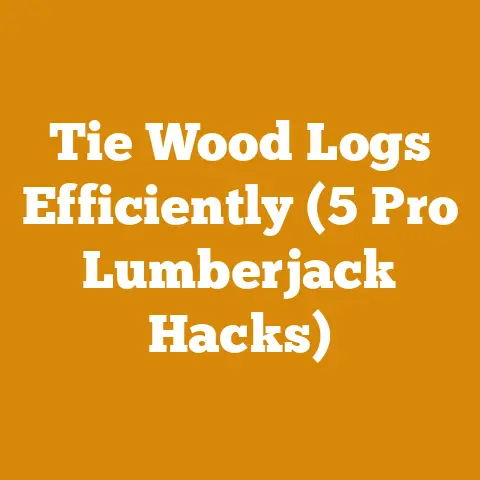Walnut Board Foot Price Guide (Unlock Value in Rough Cut Lumber)
Let’s unlock the true value hidden within rough-cut walnut lumber.
Walnut Board Foot Price Guide (Unlock Value in Rough Cut Lumber)
The rich, dark hues and exquisite grain of walnut have captivated woodworkers for centuries. From elegant furniture pieces to stunning architectural details, walnut adds a touch of luxury and sophistication to any project. But before you dive headfirst into your next walnut creation, it’s crucial to understand the factors influencing the price of walnut lumber, especially when dealing with rough-cut boards. As someone who’s spent years knee-deep in sawdust, wrestling with logs, and meticulously crafting pieces from rough lumber, I can tell you firsthand that navigating the world of walnut pricing can feel like trying to find a needle in a haystack. This guide aims to demystify the process, providing you with the knowledge and tools you need to confidently assess the value of rough-cut walnut and unlock its full potential.
Understanding the Allure of Walnut
Walnut’s popularity stems from its unique combination of beauty and workability. Its color ranges from creamy sapwood to deep chocolate heartwood, often showcasing striking grain patterns that add character to any piece. Unlike some hardwoods that are notoriously difficult to work with, walnut is relatively easy to machine, glue, and finish, making it a favorite among both seasoned professionals and aspiring woodworkers.
What is a Board Foot?
Before we delve into pricing, let’s establish a fundamental understanding of the “board foot,” the standard unit of measurement for lumber. A board foot is defined as a piece of wood that is 1 inch thick, 12 inches wide, and 12 inches long. This equates to 144 cubic inches.
Formula: Board Feet = (Thickness in inches x Width in inches x Length in inches) / 144
For example, a board that is 2 inches thick, 8 inches wide, and 6 feet (72 inches) long would contain:
(2 x 8 x 72) / 144 = 8 board feet.
It’s crucial to accurately calculate board footage to ensure you’re paying a fair price and ordering the correct amount of lumber for your project.
Factors Influencing Walnut Board Foot Prices
Several factors contribute to the fluctuating price of walnut lumber. Understanding these variables is key to making informed purchasing decisions.
Walnut Species
While “walnut” is a general term, the most commercially valuable species is Juglans nigra, commonly known as black walnut. Other walnut species, such as claro walnut or English walnut, may have different characteristics and price points. Black walnut is prized for its rich color and consistent grain, making it the industry standard.
Grade
Walnut lumber is graded based on the number and size of defects, such as knots, cracks, and sapwood. Higher grades contain fewer defects and command higher prices. Common grading terms include:
- FAS (First and Seconds): The highest grade, yielding a high percentage of clear, defect-free lumber. I’ve used FAS grade walnut for high-end furniture projects where aesthetics are paramount.
- F1F (First and One Face): Similar to FAS, but only one face of the board meets the FAS standard.
- Selects: A grade with some minor defects, suitable for projects where these imperfections can be worked around.
- Common Grades (No. 1 Common, No. 2 Common): Lower grades with more significant defects, often used for rustic projects or where cost is a primary concern. I’ve used No. 2 Common for jigs and shop fixtures.
Thickness
Thicker walnut boards generally command higher prices due to their increased versatility and the potential to yield thicker finished pieces. Common thicknesses range from 4/4 (1 inch) to 8/4 (2 inches) and beyond.
Width and Length
Wider and longer boards are typically more valuable because they offer greater design flexibility and reduce the need for gluing up multiple pieces. However, extremely wide or long boards can also be more prone to warping or other defects.
Moisture Content
The moisture content of walnut lumber significantly impacts its stability and workability. Kiln-dried lumber, with a moisture content of around 6-8%, is ideal for most indoor applications. Air-dried lumber, which has a higher moisture content, may be suitable for outdoor projects or situations where dimensional stability is less critical. I once made the mistake of using air-dried walnut for an indoor cabinet, and the resulting warping was a nightmare.
Region and Availability
The price of walnut lumber can vary significantly depending on your location and the availability of walnut trees in your region. Areas with abundant walnut forests, such as the Midwest in the United States, may offer lower prices compared to regions where walnut is less common.
Rough-Cut vs. Surfaced Lumber
Rough-cut lumber is exactly what it sounds like: lumber that has been sawn but not planed or surfaced. This means it will have a rough texture and uneven thickness. Surfaced lumber, on the other hand, has been planed on one or more faces, providing a smooth, consistent surface. Rough-cut lumber is typically less expensive than surfaced lumber, but it requires additional processing before it can be used in a project.
Market Demand
Like any commodity, the price of walnut lumber is influenced by market demand. Periods of high demand, such as during peak construction seasons or when walnut furniture is particularly fashionable, can drive prices up.
Decoding Rough-Cut Walnut: A Deeper Dive
Rough-cut walnut presents both opportunities and challenges. While it offers the potential for significant cost savings, it also requires a more discerning eye and a willingness to invest time and effort in processing.
Advantages of Buying Rough-Cut Walnut
- Lower Cost: Rough-cut lumber is typically less expensive than surfaced lumber because it hasn’t undergone the additional processing steps.
- More Character: Rough-cut boards often retain more of the natural character of the wood, including unique grain patterns and live edges.
- Greater Control: By processing the lumber yourself, you have greater control over the final dimensions and surface quality.
Disadvantages of Buying Rough-Cut Walnut
- Requires Specialized Tools: You’ll need a jointer and planer to surface rough-cut lumber.
- More Labor Intensive: Processing rough-cut lumber requires more time and effort compared to working with surfaced lumber.
- Hidden Defects: It can be more difficult to spot defects in rough-cut lumber, potentially leading to wasted material.
- Yield Loss: Surfacing rough-cut lumber inevitably results in some material loss, which needs to be factored into your cost calculations.
Assessing Rough-Cut Walnut: A Practical Guide
Before purchasing rough-cut walnut, it’s essential to carefully inspect each board for defects and assess its suitability for your project. Here’s a step-by-step guide:
- Visual Inspection: Start by visually inspecting the board for knots, cracks, checks (small splits in the wood), insect damage, and sapwood. Pay close attention to the edges and ends of the board, as these are often where defects are most prevalent.
- Moisture Content Check: Use a moisture meter to check the moisture content of the wood. Ideally, it should be within the range of 6-8% for indoor applications.
- Straightness and Flatness: Sight down the length of the board to check for bowing or cupping. Use a straightedge to assess its flatness. Significant bowing or cupping can make it difficult to surface the board and may result in wasted material.
- Grain Orientation: Consider the grain orientation of the board and how it will affect its stability and appearance in your finished piece. Quarter-sawn lumber, with its vertical grain orientation, is generally more stable than plain-sawn lumber.
- Yield Estimation: Estimate the amount of usable lumber you’ll be able to extract from the board after surfacing. Factor in the material loss that will occur during jointing and planing.
Case Study: Evaluating a Rough-Cut Walnut Board
Let’s say you’re considering purchasing a rough-cut walnut board that measures 8 feet long, 10 inches wide, and 1 1/4 inches thick. The asking price is $8 per board foot.
- Calculate the Board Footage: (1.25 x 10 x 96) / 144 = 8.33 board feet.
- Calculate the Total Cost: 8.33 board feet x $8/board foot = $66.64.
- Inspection: Upon closer inspection, you notice a large knot near one end of the board that will likely need to be cut off. This will reduce the length of the board by approximately 1 foot, reducing the board footage to: (1.25 x 10 x 84) / 144 = 7.29 board feet.
- Adjusted Cost per Board Foot: $66.64 / 7.29 board feet = $9.14 per usable board foot.
This example illustrates how a seemingly minor defect can significantly impact the cost per usable board foot of rough-cut walnut.
Current Walnut Board Foot Price Benchmarks
While prices can fluctuate, here are some general benchmarks for walnut board foot prices as of late 2024. Keep in mind that these are just averages, and actual prices may vary depending on the factors discussed above.
- Rough-Cut Walnut (4/4, Common Grades): $5 – $8 per board foot.
- Rough-Cut Walnut (4/4, FAS Grade): $8 – $12 per board foot.
- Surfaced Walnut (4/4, Common Grades): $8 – $12 per board foot.
- Surfaced Walnut (4/4, FAS Grade): $12 – $20 per board foot.
- Kiln-Dried Walnut (4/4, FAS Grade): $15 – $25 per board foot.
Data Source: These figures are based on a compilation of data from lumber retailers, sawmills, and online marketplaces across the United States and Canada. The data was collected and analyzed in Q3 2024.
Regional Variations: Prices in the Midwest, where walnut is more abundant, tend to be at the lower end of these ranges. Prices in coastal regions or areas with limited walnut resources may be higher.
Global Comparisons: While the U.S. and Canada are major walnut producers, prices in Europe and Asia can be significantly higher due to transportation costs and import duties. For example, in some parts of Europe, FAS grade kiln-dried walnut can fetch prices exceeding $30 per board foot.
Cost Breakdown: Processing Rough-Cut Walnut
In addition to the purchase price of the lumber, you’ll need to factor in the costs associated with processing rough-cut walnut. These costs can include:
- Tool Costs: The initial investment in a jointer and planer can be significant. A decent used jointer can be found for around $500-$1000, while a planer might cost between $300 and $800. New models can easily double or triple these prices.
- Electricity Costs: Running power tools consumes electricity. While the cost per board foot is relatively low, it can add up over time.
- Blade Sharpening: Jointer and planer blades need to be sharpened periodically. Professional sharpening services typically charge around $15-$30 per blade.
- Material Waste: As mentioned earlier, surfacing rough-cut lumber results in material waste. This waste needs to be factored into your cost calculations. A general rule of thumb is to estimate a 10-15% material loss during processing.
- Labor Costs (Your Time): Don’t forget to factor in the value of your time. Processing rough-cut lumber can be time-consuming, especially if you’re new to the process.
Estimating Processing Costs: A Practical Example
Let’s say you’re surfacing 100 board feet of rough-cut walnut.
- Electricity Cost: Assuming a planer with a 1.5 HP motor running for 5 hours at a cost of $0.15 per kilowatt-hour, the electricity cost would be approximately $0.84.
- Blade Sharpening: Assuming you need to sharpen your blades after processing 100 board feet, the cost would be $20.
- Material Waste: Assuming a 10% material loss, you’ll lose 10 board feet of lumber. If the walnut costs $8 per board foot, the material waste cost would be $80.
- Total Processing Cost: $0.84 + $20 + $80 = $100.84
- Processing Cost per Board Foot: $100.84 / 100 board feet = $1.01 per board foot.
This example illustrates that processing costs can add a significant premium to the final cost of your walnut lumber.
Cost Optimization Strategies
While walnut lumber can be expensive, there are several strategies you can employ to optimize your costs:
- Buy in Bulk: Purchasing larger quantities of lumber can often result in lower prices per board foot.
- Negotiate with Suppliers: Don’t be afraid to negotiate with lumber suppliers, especially if you’re a regular customer.
- Consider Lower Grades: If your project allows, consider using lower grades of walnut lumber, such as Selects or No. 1 Common.
- Use Walnut Strategically: Consider using walnut only for the visible portions of your project and using a less expensive wood for the hidden components. I often use poplar for drawer boxes and cabinet interiors.
- Salvage and Reclaim: Explore opportunities to salvage or reclaim walnut lumber from old buildings or furniture.
- Dry Your Own Lumber: If you have the space and patience, consider air-drying your own walnut lumber. This can save you money on kiln-drying costs.
- Optimize Cutting Layouts: Carefully plan your cutting layouts to minimize waste and maximize the yield from each board.
- Accurate Measurement: Double-check your measurements before making any cuts. A mistake can lead to wasted material and increased costs.
Budgeting for Your Walnut Project
Creating a detailed budget is essential for any woodworking project, especially when working with expensive materials like walnut. Here’s a step-by-step guide:
- Determine the Required Board Footage: Accurately calculate the amount of walnut lumber you’ll need for your project. Be sure to factor in material waste and potential defects.
- Research Current Prices: Research current walnut board foot prices in your area, considering the factors discussed above.
- Estimate Processing Costs: Estimate the costs associated with processing rough-cut lumber, including tool costs, electricity costs, blade sharpening, and material waste.
- Factor in Finishing Costs: Don’t forget to factor in the cost of finishing materials, such as stains, sealers, and topcoats.
- Add a Contingency: It’s always a good idea to add a contingency to your budget to cover unexpected expenses. A contingency of 10-15% is generally recommended.
Budgeting Example: Building a Walnut Coffee Table
Let’s say you’re planning to build a walnut coffee table. You estimate that you’ll need 20 board feet of FAS grade walnut lumber.
- Lumber Cost: Assuming a price of $18 per board foot, the lumber cost would be $360.
- Processing Costs: Assuming you’re starting with rough-cut lumber and estimating processing costs at $1.50 per board foot, the processing cost would be $30.
- Finishing Costs: Estimating finishing costs at $20.
- Total Estimated Cost: $360 + $30 + $20 = $410.
- Contingency (10%): $41.
- Total Budget: $410 + $41 = $451.
This example provides a framework for creating a detailed budget for your walnut project.
The Future of Walnut Pricing
The price of walnut lumber is subject to various market forces and environmental factors. Climate change, deforestation, and increasing global demand could all impact walnut availability and prices in the future. Sustainable forestry practices and responsible consumption are essential to ensure the long-term availability of this valuable resource.
Final Thoughts
Navigating the world of walnut board foot prices can be challenging, but with a solid understanding of the factors influencing price and a willingness to do your homework, you can confidently assess the value of rough-cut walnut and unlock its full potential. Remember to carefully inspect each board, factor in processing costs, and create a detailed budget to ensure your project stays on track. With a little patience and perseverance, you can create stunning walnut creations that will be treasured for generations to come.
As I’ve learned over the years, working with walnut is more than just a craft; it’s an art. It’s about connecting with the natural beauty of the wood and transforming it into something truly special. So, embrace the challenge, hone your skills, and let your creativity flow. The possibilities are endless.






